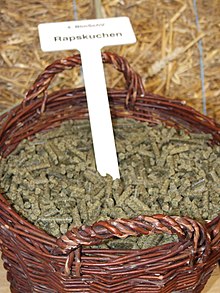Rapeseed cake
Rapeseed cake , also called rapeseed expeller , is the solid pressing residue that occurs as a by-product of the cold pressing of rapeseed oil . Depending on the pressing technique and processing used, rapeseed cake comes in the form of pellets or flakes. The cold pressing yield for rapeseed cakes is around 70 percent. Rapeseed cake is currently mainly used as a high-fat and protein-rich animal feed.
Demarcation
Press cakes from other oilseeds are made in the same way as rapeseed cakes, but differ in terms of their properties, possible uses and market significance. Oil extraction with the aid of solvents - the process usually used in industrial oil mills - is a low-fat and high-protein by-product of rapeseed meal (RES).
generation
The mechanical cold pressing of rapeseed without the use of solvents or heating is a technologically relatively simple process and is usually used by smaller, decentralized oil mills . A significant proportion of the oil remains in the press cake as solid press residue.
In today's conventional screw presses , the press residue emerges at the end of the screw. While in Lochseiher screw presses, which are mainly designed for smaller production plants up to 75 kg rapeseed per hour, a press nozzle on the press head defines the cylindrical shape of the rapeseed cake, the press residue is shaped in the larger Sieher bar screw presses (up to 3,000 kg / h) small platelets (flakes or flakes) are discharged if no pelletizing device is available.
Ingredients and properties
Rapeseed cake contains around 11 percent fat, with a considerable range of up to over 20 percent depending on the strength of the pressing. The protein content is 30 to 36 percent, with 7.8-13.7 percent as crude fiber. The ingredients, especially the fat content, vary significantly depending on the process (technology used, temperature, degree of extraction, etc.). The lower calorific value of rapeseed press cake is approx. 22 MJ ( other calorific values of solid fuels ), the ash content can be up to eight percent and is therefore relatively high.
use
Farm animal feeding
Rapeseed cake is mainly used in high-performance feeding for cattle, pigs and broilers. Similar to rapeseed meal, rapeseed cake is also a protein-rich animal feed, but with a significantly higher fat content.
The use as performance feed is mainly limited by the glucosinolate content , which can lead to reduced feed consumption and possibly to health disorders. The spread of the so-called 00 rape varieties , which are low in glucosinolate, enables higher proportions of rape cakes in feed today than a few decades ago. Since ruminants such as cattle are less sensitive to glucosinolates in feed than monogastric animals such as pigs and poultry, the majority of the rapeseed cake is used in cattle feed.
Omega-3 fatty acids in rapeseed cake, which are necessary for human nutrition, increase the concentration of these fatty acids in the meat and milk of the animals fed on them. Animal products with increased omega-3 fatty acids due to the feed of rapeseed cakes are occasionally marketed specifically as health-promoting foods.
Alternative uses
Other possible uses are energy production from rapeseed cake by fermentation in biogas plants or by incineration. Rapeseed cake can also be used as an organic fertilizer and processed for technical purposes, e.g. B. for protein extraction, for packaging or for insulating material .
economy
Around a quarter of an oil mill's turnover is generated from the proceeds from the sale of rapeseed cakes.
In March 2007, the TFZ estimated the production capacity of the approximately 575 decentralized oil mills in Germany known to the Technologie- und Förderzentrum (TFZ) at 700,000 tons of rapeseed cake. Production in Holland is estimated at around 40,000 tons. In France, the production of cold-pressed rapeseed oil and therefore also rapeseed cake production mostly takes place in small businesses that process a few kilograms of rapeseed per hour. The processing capacities of the oil mills in Germany and thus the output of rapeseed cakes have risen sharply in recent years. In contrast to the main product rapeseed oil, sales of rapeseed cakes have developed positively.
Under current market conditions, the market price of rapeseed cakes as animal feed clearly exceeds the prices achievable with all other quantity-relevant uses. Therefore, rapeseed cake is almost exclusively used in cattle feed today.
literature
Much of the information in this article has been obtained from the following sources:
- Martin Kaltschmitt, Hans Hartmann and Hermann Hofbauer (eds.), 2009: Energy from biomass. Basics, techniques and procedures. Springer Verlag, 2nd edition, pp. 727–728 and 764–766, ISBN 9783540850946
- Florian Gerlach: Rape cake, more than just a by-product , in: New Energy, April 2007, pp. 25-27.
Individual evidence
- ↑ Florian Gerlach: New Diversity for Rapeseed Cakes , in: Forum New Power 3/2007, p. 31
Web links
- Rapeseed cake - a high-quality animal feed (Chamber of Agriculture NRW)
